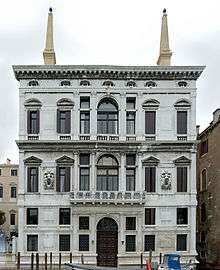Palazzo Papadopoli
The Palazzo Papadopoli is a Baroque-style palace located on the Canal Grande of Venice, between Palazzo Giustinian Businello and Palazzo Donà a Sant'Aponal in the Sestiere of San Polo, Venice, Italy. Coordinates: 45°26′12″N 12°19′55″E / 45.436781°N 12.332043°E

History
The palace was commissioned in the middle of the 16th century by the Coccina family from the architect Giangiacomo dei Grigi, son of Guglielmo dei Grigi. This family from Bergamo had recently joined the Venetian patriciate.[1] The palace was complete by 1570.
In 1748, the palace came to hands of the Tiepolo family.[2][3] In 1745, the palace and remaining painting collection was sold to the elector of Saxony for 100,000 zucchini. The paintings were moved to the Gemäldegalerie Alte Meister of Dresden.[4] In the 1700a, the piano nobile was decorated by Giandomenico Tiepolo with frescoes of The charlatan and The Minuette .[5] His father, Giambattista Tiepolo circa 1750, also putatively painted one ceiling.[6][7][8]
The palace changed hands during 19th century from Valentino Comello in 1837, whose wife Maddalena Montalban was jailed by the Austrians for a year; to Bartholomäus von Stürmer, Austrian general and diplomat; to Counts Niccolò and Angelo Papadopoli in 1864. The family from Corfu, entered the patriciate in 1791. between 1874-1875, it housed Girolamo Levi, who along with Michelangelo Guggenheim and Cesare Rotta completed a Neoclassical refurbishment with gardens.[9][10] Rotta frescoed the ballroom. In 1922, it was inherited by the family of Arrivabene Valenti Gonzaga. The palace is being converted to a luxury hotel.[11]
References
- ↑ Brusegan p. 62
- ↑ Brusegan p. 64.
- ↑ Palazzo Coccina Tiepolo Papadopoli su venezia.jc-r.net
- ↑ Brusergan, page 64.
- ↑ Fasolo
- ↑ veneziajcrnet
- ↑ Giambattista Tiepolo su venezia.jc-r.net
- ↑ Content in this edit is translated from the existing Italian Wikipedia article at it:Palazzo Papadopoli; see its history for attribution.
- ↑ Fasolo
- ↑ brusegan, page 64.
- ↑ veneziajcrnet
Sources
- Guida d'Italia – Venezia ed. Milano, Touring Editore, 2007. ISBN 978-88-365-4347-2.
- Brusegan, Marcello (2007). Newton & Compton, ed. I palazzi di Venezia. Roma. pp. 62–64. ISBN 978-88-541-0820-2. Brusegan.
- Fasolo, Andrea (2003). Arsenale editrice, ed. Palazzi di Venezia. pp. 76–77. ISBN 978-88-7743-295-7. Fasolo.
- Boulton, Susie; Catling, Christopher. Mondadori, ed. Venezia e il Veneto. p. 64. ISBN 978-88-04-43092-6. Boulton e Catling.